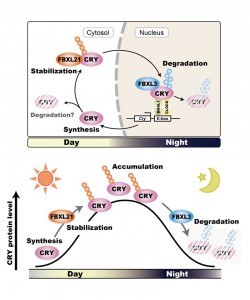Molecular mechanism of circadian clock regulating mouse behavioral rhythm Stabilization and degradation of CRY critical for stable oscillation of the circadian clock.


© Yoshitaka Fukada. In the daytime, FBXL21 stabilizes CRY proteins and contributes to the accumulation of CRY proteins in the cytosol. At nighttime, FBXL3 mediates CRY degradation in the nucleus, and CRY protein levels decrease. Stabilization and degradation of CRY protein by two related F-box proteins regulates the stable oscillation of the circadian clock and behavioral rhythms.
Dr. Yoshitaka Fukada and Arisa Hirano (Graduate School of Science, The University of Tokyo), collaborating with Dr. Keiichi I. Nakayama (Medical Institute of Bioregulation, Kyushu University), indicate a molecular mechanism for generating the protein rhythm of mouse CRY, critical players in the circadian clock. Previous research reported that an F-box-type ubiquitin ligase FBXL3 ubiquitinates CRYs. CRY proteins modified by FBXL3-mediated ubiquitination are subject to degradation. In contrast, the researchers found in this study that FBXL21 that closely resembles FBXL3 ubiquitinates and, surprisingly, stabilizes CRY proteins. FBXL21-dependent stabilization contributes to CRY protein accumulation in the daytime. It has been well established that F-box protein-mediated ubiquitination leads the target protein to degradation. This pioneering work is the first example of CRY protein stabilization through ubiquitination by F-box-type E3 ligase, revealing the physiological importance of ubiquitination-mediated protein stabilization in the mammal. FBXL3 and FBXL21 knockout mice exhibited unstable behavioral rhythms in constant darkness. These results demonstrate that stabilization and degradation of CRY proteins by FBXL21 and FBXL3 are essential for the stable oscillation of the circadian clock and behavioral rhythms. Much clinical data shows that dysregulation of circadian rhythms is the cause of many diseases including sleep disorder, some types of cancer and metabolic syndrome. This study describing the oscillatory mechanism of the circadian clock could provide hints to developing effective therapeutic targets against these diseases.
Press release (Japanese)
Paper
Arisa Hirano, Kanae Yumimoto, Ryosuke Tsunematsu, Masaki Matsumoto, Masaaki Oyama, Hiroko Kozuka-Hata, Tomoki Nakagawa, Darin Lanjakornsiripan, Keiichi I. Nakayama, Yoshitaka Fukada,
“FBXL21 Regulates Oscillation of the Circadian Clock through Ubiquitination and Stabilization of Cryptochromes”,
Cell 152 (2013):1106. doi: 10.1016/j.cell.2013.01.054.
Article link
Links
Department of Biophysics and Biochemistry, Graduate School of Science
Fukada Laboratory, Department of Biophysics and Biochemistry, Graduate School of Science







